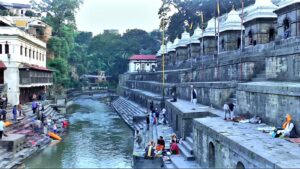7 Shocking Truths Kathmandu & Pashupatinath Temple Mysteries

Kathmandu, nestled in the majestic mountains of the Himalayas, is a city brimming with history, spirituality, and mystery. Once believed to have been a vast, snake-filled pond, Kathmandu has transformed into a vibrant cultural hub that boasts seven UNESCO World Heritage Sites, powerful tantric traditions, and one of the largest open cremation grounds in the world.
At the heart of this ancient city lies the sacred Pashupatinath Temple, a shrine dedicated to Lord Shiva, which draws pilgrims and travelers from all corners of the globe. Known for its contrasts — where life and death coexist, where myths blend with history, and where the divine meets the earthly — Kathmandu’s temples, stories, and rituals make it a place of wonder and intrigue, waiting to be explored. Here are seven untold facts about Kathmandu and the legendary Pashupatinath Temple.
1. Mysteries and Secrets of Kathmandu

Kathmandu holds countless secrets hidden in every corner of its streets and temples. Although the city has embraced modernization, its ancient temples still whisper stories of the past. In April 2015, a devastating earthquake shook the city, causing massive destruction. More than 9,000 people lost their lives, buried under collapsed buildings. Yet, remarkably, Pashupatinath Temple stood unharmed amidst the devastation, symbolizing its deep spiritual power.
2. The Sacred Pashupatinath Temple

Situated on the banks of the Bagmati River, the Pashupatinath Temple is one of the holiest temples for Hindus. Here, visitors can witness 100 Shiva Lingas at a time. The most famous of them is the Swayambhu Linga, meaning “self-appeared.” According to the Nepal Mahatmya, Lord Shiva once rested in Kathmandu disguised as a deer. When Lord Vishnu tried to take him back, Shiva’s deer horn broke, and a Linga emerged from the spot. This Mukha Linga is the main attraction today, with four faces representing different forms of Shiva. Some tantric texts claim it has a fifth, hidden face known as Kaalagni Rudra, visible only to those with tantric knowledge.
3. The Living Goddess: Kumari of Kathmandu

Another fascinating story is that of the Kumari Devi, a living goddess believed to embody Goddess Durga. Every few years, a young girl from the Shakya caste is chosen through sacred rituals to become the Kumari and is worshipped as a goddess until she reaches puberty. The Kumari Ghar, where she resides, was miraculously unharmed during the 2015 earthquake. This tradition is centuries old and continues to captivate both locals and tourists.
4. Nara Devi Temple: A Center of Tantra

Kathmandu is not just a religious hub but also a center for Tantric practices, especially at the Nara Devi Temple, which is dedicated to Shweta Kali. According to legend, a king from Patan was once saved by Shweta Kali from a wild elephant attack in a nearby forest. In gratitude, he built the Nara Devi Temple, now known for its tantric rituals. Every year during Vijayadashami, a buffalo is sacrificed at the temple, following ancient tantric traditions that involve the offering of blood.
5. The Power of Kirtimukha Bhairav

Kathmandu’s association with Tantra goes further. At the Kirtimukha Bhairav Temple, the most dangerous form of Shiva is worshipped through rituals involving five sacrifices—animals offered to please Kaal Bhairav. This tradition is believed to help devotees attain moksha, or liberation from the cycle of life and death. The connection between tantric practices and liberation is deeply embedded in Kathmandu’s culture.
6. The Open Cremation Ground: Aarya Ghat

One of the most striking features of Pashupatinath is its open cremation ground, Aarya Ghat, on the banks of the Bagmati River. Here, bodies of the deceased are cremated in public view. It is believed that those cremated at Aarya Ghat are freed from the cycle of rebirth and attain salvation. While the temple hosts daily prayers and rituals, this stark reality of life and death unfolds simultaneously, offering a profound spiritual reflection for those who visit.
7. A Land of Two Faiths: Hinduism and Buddhism

Kathmandu is not only significant for Hinduism, but also for Buddhism. It is a city where these two ancient religions coexist harmoniously. Alongside the sacred temples of Lord Shiva, the city is home to some of the most revered Buddhist sites, including the Boudhanath Stupa and Swayambhunath (the Monkey Temple). The spiritual energy of Kathmandu, rooted in the presence of Lord Shiva and Buddha, makes it one of the holiest cities in the world.
Kathmandu’s rich history, myths, and sacred sites continue to draw pilgrims and travelers from all over the globe. The stories and secrets held within its temples like Pashupatinath, Kumari Ghar, and Nara Devi add layers of mysticism to this already enchanting city.
Conclusion
Kathmandu, with its ancient temples, mystical stories, and spiritual significance, stands as a beacon of both Hinduism and Buddhism. The city’s deep-rooted history, from the legend of Lord Shiva at Pashupatinath to the living goddess Kumari, reflects a rich tapestry of faith and tradition. Despite facing natural disasters like the devastating 2015 earthquake, Kathmandu’s resilience and spiritual heritage remain unshaken. This city continues to mesmerize visitors with its blend of beauty, mystery, and devotion. Whether it’s the tantric rituals at Nara Devi or the serene yet powerful atmosphere of Pashupatinath, Kathmandu offers a profound journey into the heart of Nepalese spirituality and history, making it a place unlike any other in the world.


1 thought on “7 Shocking Truths Kathmandu & Pashupatinath Temple Mysteries”